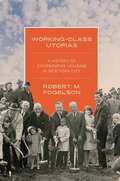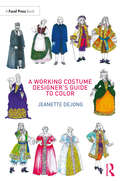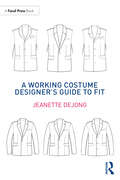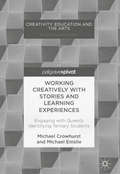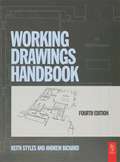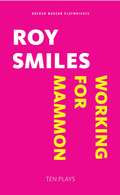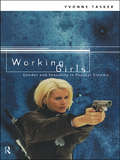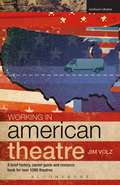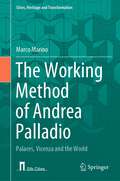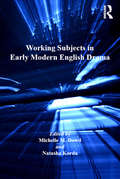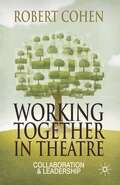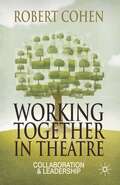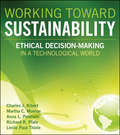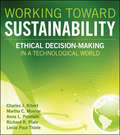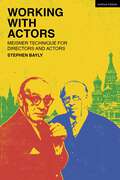- Table View
- List View
Working-Class Utopias: A History of Cooperative Housing in New York City
by Robert M. FogelsonOne of the nation’s foremost urban historians traces the history of cooperative housing in New York City from the 1920s through the 1970sAs World War II ended and Americans turned their attention to problems at home, union leaders and other prominent New Yorkers came to believe that cooperative housing would solve the city’s century-old problem of providing decent housing at a reasonable cost for working-class families. Working-Class Utopias tells the story of this ambitious movement from the construction of the Amalgamated Houses after World War I to the building of Co-op City, the world’s largest housing cooperative, four decades later.Robert Fogelson brings to life a tumultuous era in the life of New York, drawing on a wealth of archival materials such as community newspapers, legal records, and personal and institutional papers. In the early 1950s, a consortium of labor unions founded the United Housing Foundation under the visionary leadership of Abraham E. Kazan, who was supported by Nelson A. Rockefeller, Robert F. Wagner Jr., and Robert Moses. With the help of the state, which provided below-market-rate mortgages, and the city, which granted tax abatements, Kazan’s group built large-scale cooperatives in every borough except Staten Island. Then came Co-op City, built in the Bronx in the 1960s as a model for other cities but plagued by unforeseen fiscal problems, culminating in the longest and costliest rent strike in American history. Co-op City survived, but the United Housing Foundation did not, and neither did the cooperative housing movement.Working-Class Utopias is essential reading for anyone seeking to understand the housing problem that continues to plague New York and cities across the nation.
A Working Costume Designer's Guide to Color
by Jeanette deJongA Working Costume Designer's Guide to Color provides readers with the skills and knowledge to create coherent color schemes for costumes. Drawing on decades of experience in the costume shop, the author guides readers through every step of the process, from finding inspiration for a color scheme and successfully working with the design team to understanding how lighting design can affect costume color choices. Filled with step-by-step illustrations of how to add colors to a set of renderings and color-block samples to illustrate color theory, terminology, and usage of colors, the book covers a wide range of topics, including: How to add colors to a set of renderings to clarify characters and character relationships. How color interacts with surface pattern and fabric textures. Color theory and terminology. How to combine colors to make a coherent color scheme using different methods, including using dominant, supporting, and accent colors. How to flatter actors while staying within an overall color scheme. Color meanings in different cultures and for different time periods. How to manage costume changes to preserve or extend a color scheme. A valuable resource for students of costume design courses and professional costume designers, A Working Costume Designer's Guide to Color provides readers with the tools to create harmonious color schemes that will enhance the look of a production as whole.
A Working Costume Designer's Guide to Color
by Jeanette deJongA Working Costume Designer's Guide to Color provides readers with the skills and knowledge to create coherent color schemes for costumes. Drawing on decades of experience in the costume shop, the author guides readers through every step of the process, from finding inspiration for a color scheme and successfully working with the design team to understanding how lighting design can affect costume color choices. Filled with step-by-step illustrations of how to add colors to a set of renderings and color-block samples to illustrate color theory, terminology, and usage of colors, the book covers a wide range of topics, including: How to add colors to a set of renderings to clarify characters and character relationships. How color interacts with surface pattern and fabric textures. Color theory and terminology. How to combine colors to make a coherent color scheme using different methods, including using dominant, supporting, and accent colors. How to flatter actors while staying within an overall color scheme. Color meanings in different cultures and for different time periods. How to manage costume changes to preserve or extend a color scheme. A valuable resource for students of costume design courses and professional costume designers, A Working Costume Designer's Guide to Color provides readers with the tools to create harmonious color schemes that will enhance the look of a production as whole.
A Working Costume Designer’s Guide to Fit
by Jeanette deJongA Working Costume Designer’s Guide to Fit explores the concept of fit in theatrical costumes – what it is, how to assess it, and how to achieve it. Being able to assess whether a costume fits or not is a learned skill, which takes practice as well as information about what the fit standards are for different types of garments. Filled with detailed step-by-step illustrations, this book provides all the knowledge readers will need in order to achieve the perfect fit for their costumes, including: How costumes can support actors onstage when they fit correctly. How to take measurements and how to assess them. How to conduct a fitting and what materials are needed. How to resolve a number of issues that may arise during a fitting. How to fit a mockup test garment in preparation for building a costume from scratch. How to adjust a garment or mockup to fit better. Chapters 8-14 also explore different categories of garments and discuss how to check them against the wearer’s measurements before trying them on, what the standards of fit are for each category, and how to fit an existing garment. This is an essential guide for students of Costume Design courses and professional costume designers of any experience level.
A Working Costume Designer’s Guide to Fit
by Jeanette deJongA Working Costume Designer’s Guide to Fit explores the concept of fit in theatrical costumes – what it is, how to assess it, and how to achieve it. Being able to assess whether a costume fits or not is a learned skill, which takes practice as well as information about what the fit standards are for different types of garments. Filled with detailed step-by-step illustrations, this book provides all the knowledge readers will need in order to achieve the perfect fit for their costumes, including: How costumes can support actors onstage when they fit correctly. How to take measurements and how to assess them. How to conduct a fitting and what materials are needed. How to resolve a number of issues that may arise during a fitting. How to fit a mockup test garment in preparation for building a costume from scratch. How to adjust a garment or mockup to fit better. Chapters 8-14 also explore different categories of garments and discuss how to check them against the wearer’s measurements before trying them on, what the standards of fit are for each category, and how to fit an existing garment. This is an essential guide for students of Costume Design courses and professional costume designers of any experience level.
Working Creatively with Stories and Learning Experiences: Engaging with Queerly Identifying Tertiary Students
by Michael Crowhurst Michael EmslieStories are a valuable vehicle for practitioners in research, education, human services and the arts to enable individual and cultural change. The authors describe and deploy a variety of methods that can be used by teachers, researchers, artists, youth and community workers, and other professionals to analyse stories in ways that can promote learning and wellbeing and enhance professional practice. Offering a concise and user-friendly assemblage of techniques on how to creatively engage with stories, the authors explore and exemplify these techniques through the narratives of Queerly Identifying Tertiary Students. This practical and innovative volume will appeal to readers, researchers and practitioners alike.
Working Creatively with Stories and Learning Experiences: Engaging with Queerly Identifying Tertiary Students
by Michael Crowhurst Michael EmslieStories are a valuable vehicle for practitioners in research, education, human services and the arts to enable individual and cultural change. The authors describe and deploy a variety of methods that can be used by teachers, researchers, artists, youth and community workers, and other professionals to analyse stories in ways that can promote learning and wellbeing and enhance professional practice. Offering a concise and user-friendly assemblage of techniques on how to creatively engage with stories, the authors explore and exemplify these techniques through the narratives of Queerly Identifying Tertiary Students. This practical and innovative volume will appeal to readers, researchers and practitioners alike.
Working Drawings Handbook
by Keith StylesWorking Drawings Handbook focuses on the principles, styles, methodologies, and approaches involved in drawings. The book first takes a look at the structure of information, types of drawing, and draftsmanship. Discussions focus on dimensioning, drawing conventions, techniques, materials, drawing reproduction, location drawing, component and sub-component drawings, assembly drawing, schedule, pictorial views, and structure of working drawings. The manuscript then ponders on working drawing management and other methods. Topics include planning the set, drawing register, drawing office programming, and introducing new methods. Building elements and external features, conventions for doors and windows, symbols indicating materials, electrical, telecommunications, and fire symbols, and non-active lines and symbols are also discussed. The book is a fine reference for draftsmen and researchers interested in studying the elements of drawing.
Working Drawings Handbook
by Keith Styles Andrew BichardCovering every aspect of drawing preparation, both manual and computer-aided, this comprehensive manual is an essential tool for students, architects and architectural technologists. Showing what information is required on each type of document, how drawings relate to specifications, and how to organize and document your work, this handbook presents a fully illustrated guide to all the key methods and techniques. Thoroughly revised and redesigned, this fourth edition has brand new computer-generated drawings throughout and is updated to cover all aspects of computer use in the modern building design process.
Working Drawings Handbook
by Keith Styles Andrew BichardCovering every aspect of drawing preparation, both manual and computer-aided, this comprehensive manual is an essential tool for students, architects and architectural technologists. Showing what information is required on each type of document, how drawings relate to specifications, and how to organize and document your work, this handbook presents a fully illustrated guide to all the key methods and techniques. Thoroughly revised and redesigned, this fourth edition has brand new computer-generated drawings throughout and is updated to cover all aspects of computer use in the modern building design process.
Working for Mammon (Oberon Modern Playwrights)
by Roy SmilesWorking for Mammon is a comedy drama about the London Riots of 2012 when the city seemed to go mad for a week and every shop with training shoes got looted. It concerns a teacher defeated by life who shelters a sixteen-year-old girl on the run from the police and a drug dealer who finds in her joy for life a new meaning to go on.
Working Girls: Gender and Sexuality in Popular Cinema
by Yvonne TaskerWorking Girls investigates the thematic concerns of contemporary Hollywood cinema, and its ambivalent articulation of women as both active, and defined by sexual performance, asking whether new Hollywood cinema has responded to feminism and contemporary sexual identities. Whether analysing the rise of films centred around female friendships, or the entrance of pop stars such as Whitney Houston and Madonna into film, Working Girls is an authoritative investigation of the presence of women both as film makers and actors in contemporary mainstream cinema.
Working Girls: Gender and Sexuality in Popular Cinema
by Yvonne TaskerWorking Girls investigates the thematic concerns of contemporary Hollywood cinema, and its ambivalent articulation of women as both active, and defined by sexual performance, asking whether new Hollywood cinema has responded to feminism and contemporary sexual identities. Whether analysing the rise of films centred around female friendships, or the entrance of pop stars such as Whitney Houston and Madonna into film, Working Girls is an authoritative investigation of the presence of women both as film makers and actors in contemporary mainstream cinema.
Working in American Theatre: A brief history, career guide and resource book for over 1000 theatres (Backstage)
by Jim Volz"I cannot think of a better book for aspiring and working actors, craftspeople, artists, and managers" Kent Thompson, Artistic Director, Denver Center Theatre Company, Past President TCG Board of Directors "It's time for a new look at the complexity and richness of America's growing theatrical landscapre and Jim Volz is just the person to provide that overview" Lesley Schisgall Currier, Managing Director, Marin Shakespeare Company Working in American Theatre is a coast-to-coast overview of the opportunities awaiting theatre practitioners in every discipline. Featuring tips from America's top theatre professionals, this resource offers job-search and career-planning strategies, as well as detailed information on over 1,000 places to work in the American theatre, including regional companies, Broadway and commerical theatre, Shakespeare festivals, touring theatres, university/resident theatres, youth and children's theatres, and outdoor theatres. Offering an overview of the evolution of American theatre and behind-the-scenes stories of the regional movement, this single volume is an indispensable tool at every stage of your career.
Working in American Theatre: A brief history, career guide and resource book for over 1000 theatres (Backstage Ser.)
by Jim Volz"I cannot think of a better book for aspiring and working actors, craftspeople, artists, and managers" Kent Thompson, Artistic Director, Denver Center Theatre Company, Past President TCG Board of Directors "It's time for a new look at the complexity and richness of America's growing theatrical landscapre and Jim Volz is just the person to provide that overview" Lesley Schisgall Currier, Managing Director, Marin Shakespeare Company Working in American Theatre is a coast-to-coast overview of the opportunities awaiting theatre practitioners in every discipline. Featuring tips from America's top theatre professionals, this resource offers job-search and career-planning strategies, as well as detailed information on over 1,000 places to work in the American theatre, including regional companies, Broadway and commerical theatre, Shakespeare festivals, touring theatres, university/resident theatres, youth and children's theatres, and outdoor theatres. Offering an overview of the evolution of American theatre and behind-the-scenes stories of the regional movement, this single volume is an indispensable tool at every stage of your career.
The Working Method of Andrea Palladio: Palaces, Vicenza and the World (Cities, Heritage and Transformation)
by Marco MarinoThis book shows through historical data, diagrams and drawings, the design system of an Italian historic center, that of Vicenza, Italy. Vicenza is the result of an urban construction process that has as its model the invention of the Palladian design system. The main argument is how the architectural vision of Andrea Palladio shaped Vincenza to the city it is today. Vicenza is an example of a collective dream, an expression of the best Renaissance artistic culture, a classic example that a city can reform itself through intellectual activity.
Working Subjects in Early Modern English Drama
by Natasha KordaWorking Subjects in Early Modern English Drama investigates the ways in which work became a subject of inquiry on the early modern stage and the processes by which the drama began to forge new connections between labor and subjectivity in the period. The essays assembled here address fascinating and hitherto unexplored questions raised by the subject of labor as it was taken up in the drama of the period: How were laboring bodies and the goods they produced, marketed and consumed represented onstage through speech, action, gesture, costumes and properties? How did plays participate in shaping the identities that situated laboring subjects within the social hierarchy? In what ways did the drama engage with contemporary discourses (social, political, economic, religious, etc.) that defined the cultural meanings of work? How did players and playwrights define their own status with respect to the shifting boundaries between high status/low status, legitimate/illegitimate, profitable/unprofitable, skilled/unskilled, formal/informal, male/female, free/bound, paid/unpaid forms of work? Merchants, usurers, clothworkers, cooks, confectioners, shopkeepers, shoemakers, sheepshearers, shipbuilders, sailors, perfumers, players, magicians, servants and slaves are among the many workers examined in this collection. Offering compelling new readings of both canonical and lesser-known plays in a broad range of genres (including history plays, comedies, tragedies, tragi-comedies, travel plays and civic pageants), this collection considers how early modern drama actively participated in a burgeoning, proto-capitalist economy by staging England's newly diverse workforce and exploring the subject of work itself.
Working Subjects in Early Modern English Drama
by Natasha KordaWorking Subjects in Early Modern English Drama investigates the ways in which work became a subject of inquiry on the early modern stage and the processes by which the drama began to forge new connections between labor and subjectivity in the period. The essays assembled here address fascinating and hitherto unexplored questions raised by the subject of labor as it was taken up in the drama of the period: How were laboring bodies and the goods they produced, marketed and consumed represented onstage through speech, action, gesture, costumes and properties? How did plays participate in shaping the identities that situated laboring subjects within the social hierarchy? In what ways did the drama engage with contemporary discourses (social, political, economic, religious, etc.) that defined the cultural meanings of work? How did players and playwrights define their own status with respect to the shifting boundaries between high status/low status, legitimate/illegitimate, profitable/unprofitable, skilled/unskilled, formal/informal, male/female, free/bound, paid/unpaid forms of work? Merchants, usurers, clothworkers, cooks, confectioners, shopkeepers, shoemakers, sheepshearers, shipbuilders, sailors, perfumers, players, magicians, servants and slaves are among the many workers examined in this collection. Offering compelling new readings of both canonical and lesser-known plays in a broad range of genres (including history plays, comedies, tragedies, tragi-comedies, travel plays and civic pageants), this collection considers how early modern drama actively participated in a burgeoning, proto-capitalist economy by staging England's newly diverse workforce and exploring the subject of work itself.
Working Together in Theatre: Collaboration and Leadership
by Robert CohenRobert Cohen draws on fifty years of acting, directing and teaching experience in order to illustrate how the world's great theatre artists combine collaboration with leadership at all levels, from a production's conception to its final performance. This book challenges the notion that creating brilliant theatrical productions requires tyrannical directors or temperamental designers. Viewing the theatrical production process from the perspectives of the producer, director, playwright, actor, designer, stage manager, dramaturg and crew person, Cohen provides the techniques, exercises and language that promote successful collaborative skills in the theatre. Collaboration is vital to successful theatre making and Working Together in Theatre is the first book to show how leadership and collaboration can be combined to make every theatrical production far greater than the sum of its many parts.
Working Together in Theatre: Collaboration and Leadership
by Robert CohenRobert Cohen draws on fifty years of acting, directing and teaching experience in order to illustrate how the world's great theatre artists combine collaboration with leadership at all levels, from a production's conception to its final performance. This book challenges the notion that creating brilliant theatrical productions requires tyrannical directors or temperamental designers. Viewing the theatrical production process from the perspectives of the producer, director, playwright, actor, designer, stage manager, dramaturg and crew person, Cohen provides the techniques, exercises and language that promote successful collaborative skills in the theatre.Collaboration is vital to successful theatre making and Working Together in Theatre is the first book to show how leadership and collaboration can be combined to make every theatrical production far greater than the sum of its many parts.
Working Toward Sustainability: Ethical Decision-Making in a Technological World (Wiley Series in Sustainable Design #35)
by Charles J. Kibert Martha C. Monroe Anna L. Peterson Richard R. Plate Leslie Paul ThieleA comprehensive introduction to the ethics of sustainability for empowering professionals and practitioners in many different fields By building the framework for balancing technological developments with their social and environmental effects, sustainable practices have grounded the vision of the green movement for the past few decades. Now deeply rooted in the public conscience, sustainability has put its stamp on various institutions and sectors, from national to local governments, from agriculture to tourism, and from manufacturing to resource management. But until now, the technological sector has operated without a cohesive set of sustainability principles to guide its actions. Working Toward Sustainability fills this gap by empowering professionals in various fields with an understanding of the ethical foundations they need to promoting and achieving sustainable development. In addition, Working Toward Sustainability: Offers a comprehensive introduction to the ethics of sustainability for those in the technical fields whether construction, engineering, resource management, the sciences, architecture, or design Supports nine central principles using case studies, exercises, and instructor material Includes illustrations throughout to help bring the concepts to life By demonstrating that sustainable solutions tart with ethical choices, this groundbreaking book helps professionals in virtually every sector and field of endeavor work toward sustainability.
Working Toward Sustainability: Ethical Decision-Making in a Technological World (Wiley Series in Sustainable Design #35)
by Charles J. Kibert Martha C. Monroe Anna L. Peterson Richard R. Plate Leslie Paul ThieleA comprehensive introduction to the ethics of sustainability for empowering professionals and practitioners in many different fields By building the framework for balancing technological developments with their social and environmental effects, sustainable practices have grounded the vision of the green movement for the past few decades. Now deeply rooted in the public conscience, sustainability has put its stamp on various institutions and sectors, from national to local governments, from agriculture to tourism, and from manufacturing to resource management. But until now, the technological sector has operated without a cohesive set of sustainability principles to guide its actions. Working Toward Sustainability fills this gap by empowering professionals in various fields with an understanding of the ethical foundations they need to promoting and achieving sustainable development. In addition, Working Toward Sustainability: Offers a comprehensive introduction to the ethics of sustainability for those in the technical fields whether construction, engineering, resource management, the sciences, architecture, or design Supports nine central principles using case studies, exercises, and instructor material Includes illustrations throughout to help bring the concepts to life By demonstrating that sustainable solutions tart with ethical choices, this groundbreaking book helps professionals in virtually every sector and field of endeavor work toward sustainability.
Working with Actors: Meisner Technique for Directors and Actors
by Stephen BaylyWorking with Actors provides the key to unlocking the honest, dynamic performance every actor has within them. It offers a well-articulated formulation of the Meisner Technique easy for directors and actors to use within a working context.Through setting out an accessible training programme for practitioners working across stage and screen, this book establishes a clear-cut route to building a three-dimensional character in an organic, non-intellectual fashion, based squarely on the character's objectives.Few books in this field venture out of the training studio, while in this book - alongside offering an intense and concentrated Meisner training programme - the focus is more on the 'pay-off': the collaborative act of developing the role and how that plays out in rehearsal and performance.Beyond that, the books uniquely offers:> a new modality for script reading, analysis and rehearsal through which the character is born in relation to other characters;> a prioritisation of the key skills for coming alive in the moment – listening and putting one's attention wholly on the other character/actor;> a historical perspective on how Meisner's methods have evolved and why they provide the basis of truthful acting;> for directors, a format for analysis of the complete work based on Stanislavskian principles;> for actors, complementary methods, such as Uta Hagen's 'endowment', to enhance the 'reality of doing'
Working with Actors: Meisner Technique for Directors and Actors
by Stephen BaylyWorking with Actors provides the key to unlocking the honest, dynamic performance every actor has within them. It offers a well-articulated formulation of the Meisner Technique easy for directors and actors to use within a working context.Through setting out an accessible training programme for practitioners working across stage and screen, this book establishes a clear-cut route to building a three-dimensional character in an organic, non-intellectual fashion, based squarely on the character's objectives.Few books in this field venture out of the training studio, while in this book - alongside offering an intense and concentrated Meisner training programme - the focus is more on the 'pay-off': the collaborative act of developing the role and how that plays out in rehearsal and performance.Beyond that, the books uniquely offers:> a new modality for script reading, analysis and rehearsal through which the character is born in relation to other characters;> a prioritisation of the key skills for coming alive in the moment – listening and putting one's attention wholly on the other character/actor;> a historical perspective on how Meisner's methods have evolved and why they provide the basis of truthful acting;> for directors, a format for analysis of the complete work based on Stanislavskian principles;> for actors, complementary methods, such as Uta Hagen's 'endowment', to enhance the 'reality of doing'
Working with Children in Contemporary Performance: Ethics, Agency and Affect
by Sarah AustinThis book outlines how an innovative ‘rights-based’ model of contemporary performance practice can be used when working with children and young people.This model, framed by the United Nations Convention on the Rights of the Child (1989), challenges the idea of children as vulnerable and in need of protection, argues for the recognition of the child’s voice, and champions the creativity of children in performance. Sarah Austin draws on rich research and practitioner experience to analyse Youth Arts pedagogies, inclusive theatre practice, models of participation, the symbolic potential of the child in performance, and the work of contemporary theatre practitioners making work with children for adult audiences. The combined practical and written research reflected in this book offers a new, nuanced understanding of children as cultural agents, raising the prospect of a creative process that foregrounds deeper considerations of the strengths and capacities of children.This book would primarily appeal to scholars of theatre and performance studies, specifically those working in the field of applied theatre and theatre for children and young people. Additionally, the practice-based elements of the book are likely to appeal to theatre professionals working in youth arts or theatre for young audiences or associated fields.
